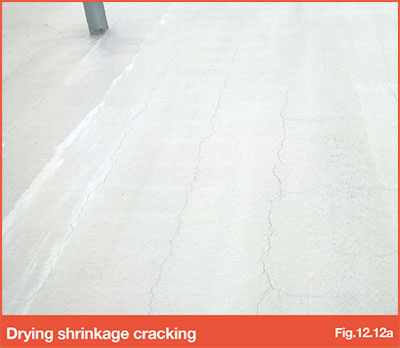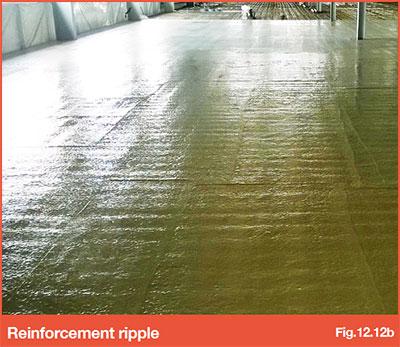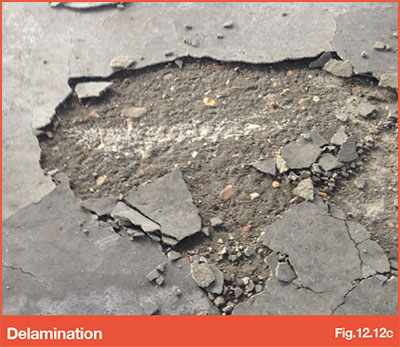12.12 - Post-installation characteristics
This section is intended to help provide an understanding of what can be expected of floor surfaces and to evaluate the significance of particular features that may be observed on a completed floor. Wherever practical, specifications should give specific criteria to be achieved, but it is recognised that some floor characteristics are not easily defined and their descriptions can be open to interpretation.
Requirements relating to surface regularity and deflection are discussed separately in 4.1 - Benefits of composite metal deck, Section 4.1.2.
Contents
12.12.1 Cracking
There is a high risk of cracking in composite floor slabs, both when the concrete is in its plastic and hardened state.
Plastic shrinkage
The main cause of plastic shrinkage cracks is rapid drying of the exposed concrete surface. If the rate of evaporation from the surface exceeds the rate at which bleed water rises to the surface, net shrinkage will occur. As the concrete has little or no intrinsic tensile strength, plastic cracking may occur. The cracks tend to be 1-2 mm wide, 300-500 mm long and 20- 50 mm deep, though in some circumstances they may extend through the full depth of a member. The pattern of plastic shrinkage cracks is usually random but may be influenced by the direction in which finishing operations have been carried out.
Materials and mix design normally have a limited influence but highly cohesive concretes with very low bleed characteristics are particularly susceptible. Concretes with low water/cement ratios or containing fine additions such as limestone powder or silica fume may also be at a higher risk. If possible to apply, re-vibration or power-floating of the concrete may help close the cracks.
Loss of moisture from the surface can be reduced by protecting the surface from drying air flows, particularly in warm weather. Protection from wind and sun is important but this is impractical when working at height with no enclosure. There are also practical difficulties in applying curing measures early enough to prevent plastic shrinkage cracking.
Plastic settlement
Settlement cracks can form at an early age while the concrete is still plastic i.e. no intrinsic tensile strength. As water moves upward, the denser constituents settle which can be obstructed by the top layer of reinforcement or by the decking profile. Arching over the obstruction brings the surface into tension causing cracks to develop at regular spacing usually following the line of the uppermost bars. There may also be shorter cracks at right angles over the bars running in the opposite direction.
High consistency concretes are more susceptible to settlement although as composite floor slabs are relatively thin, the downward movement is minimized. Re-vibration or power- floating of the concrete may help close the cracks.
Drying shrinkage and movement
Cracking in the hardened concrete is associated with the restraint to drying shrinkage, flexure over supports and deflection. Generally, cracks developed have no structural significance, providing the minimum levels of reinforcement have been detailed and placed.
Generally, most composite floor slabs are covered by flooring, e.g. raised access computer floors, so any cracking is of minimal consequence. This risk of cracking needs to be considered if bonded brittle finishes are to be applied, e.g. terrazzo tiles, coatings etc. due to the possibility of reflective cracking occurring in these types of applied finishes. Where the composite floor slab is intended to be left exposed, e.g. power-trowelled finishes, cracking can be an issue.

The frequency and appearance of cracks can be exacerbated by temporary early age loading. If cracking is a potential problem for the serviceability of the floor, the control of cracking should be considered early in the design stage by the project engineers.
12.12.2 Reinforcement ripple
Reinforcement ripple is the name given to a surface irregularity that sometimes occurs on the surface of large areas of flat concrete slabs. It takes the form of shallow troughs over the line of the reinforcement after the concrete has been finished. In some cases this just consists of a series of parallel troughs in line with the upper bars in the top mat in the slab but in the worst cases the slab takes on a quilted effect as troughs are formed over the top mat bars in both directions.
Reinforcement ripple is considered an aesthetic issue, not a structural or durability problem. There appears to be no way of preventing this when the method of finishing the concrete is by a skip/easy float or similar methods. The only known way of overcoming the problem of reinforcement ripple is to carry out further finishing operations on the slab such as powerfloating or power-trowelling, both of which prolong the finishing operation.

12.12.3 Surface laitance
Surface laitance is the development of a fine, powdery material comprising of water, cement and fine particles, that easily rubs away from the surface of hardened concrete.
Fresh concrete is a fairly cohesive mass, with the aggregates, cement, and water uniformly distributed throughout. A certain amount of time must elapse before the cement and water react sufficiently to develop hardened concrete. During this period, the cement and aggregate particles are partly suspended in the water. Because the cement and aggregates are heavier than water, they tend to sink. As they move downward, the displaced water moves upward and appears at the surface as bleed water, resulting in more water near and at the surface than in the lower portion of the concrete. Thus, the weakest, most permeable, and least wear-resistant concrete is at the top surface.
Where subsequent finishes are to be applied to concrete surfaces, consideration as to the effects of surface laitance on their installation should be given, mainly when a skip/easy float surface finish is specified. Surface laitance is more prevalent in concrete surfaces finished by skip/easy float methods where rapid drying of the surface can take place (particularly when concrete placement occurs in exposed environments subject to prevailing weather conditions i.e. rainfall, cross winds, sunlight etc.) as curing is generally applied the following day after placement, due to access restrictions.
Surface laitance can be removed by grinding off the thin/weak friable layer to expose the solid concrete underneath. Another method for consideration would be to apply a surface hardener to improve its wearing ability and reduce dusting of the surface.
12.12.4 Delamination
Delamination is the process whereby a thin (typically 2–4mm) layer becomes detached from the concrete surface. It is primarily caused by the entrapment of air and/or bleed water beneath the surface of the concrete during finishing operations.
It is believed that there is a strong link between bleed water and air within the concrete, as the air uses the fine bleed channels to escape. If closing of the surface prevents bleed water from escaping, the air can accumulate causing a weak plane and, potentially, delamination.
Several factors affect the occurrence of delamination including differential setting of the surface (the slab construction has no walls and the surface is unprotected from drying wind and solar gain), air content, bleed characteristics of the concrete and the application of a dry-shake topping. Delamination is generally only an issue when the concrete is to be the wearing surface. The surface can be reinstated using thin bonded repair mortars.

Go to NEXT section

